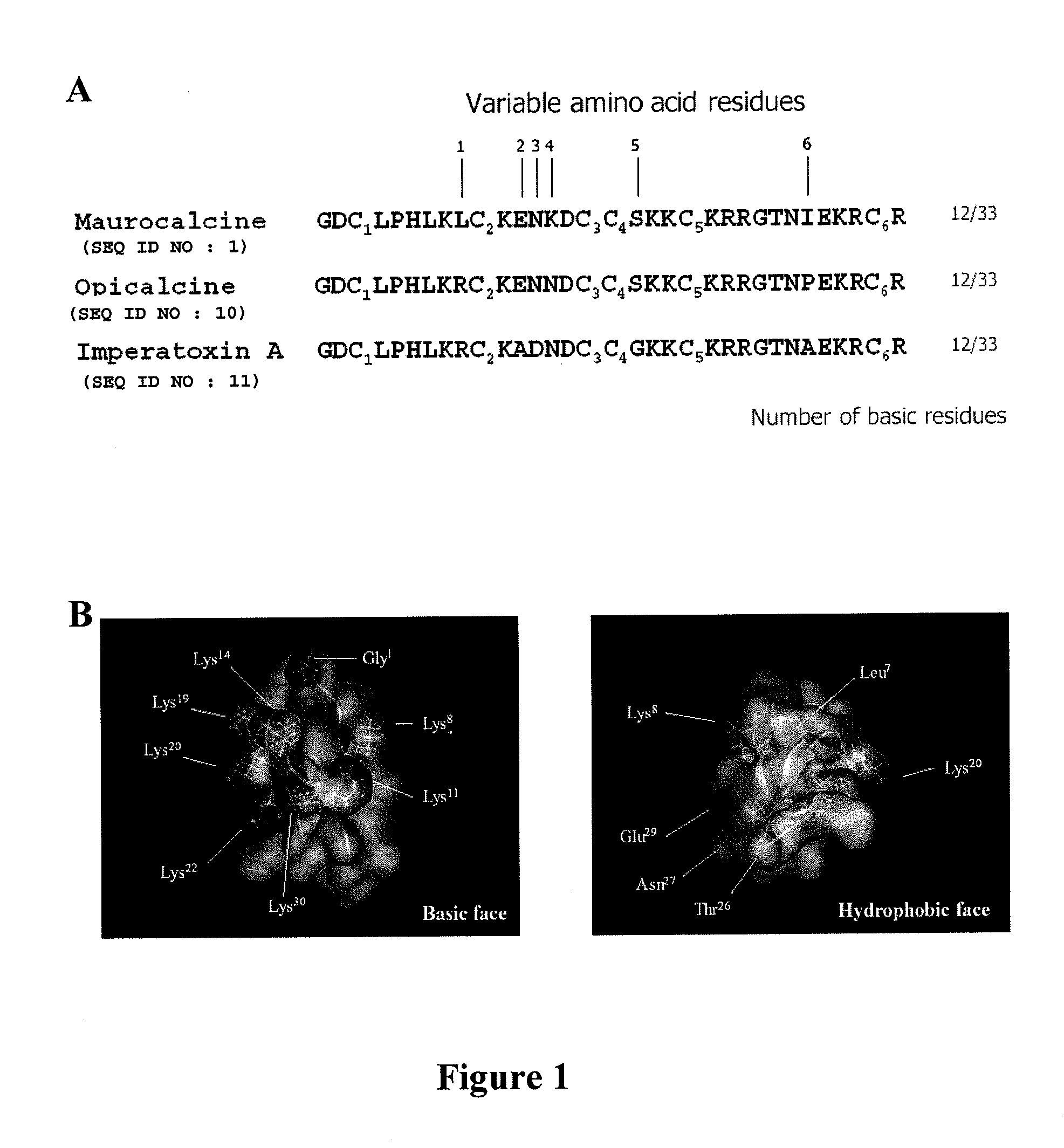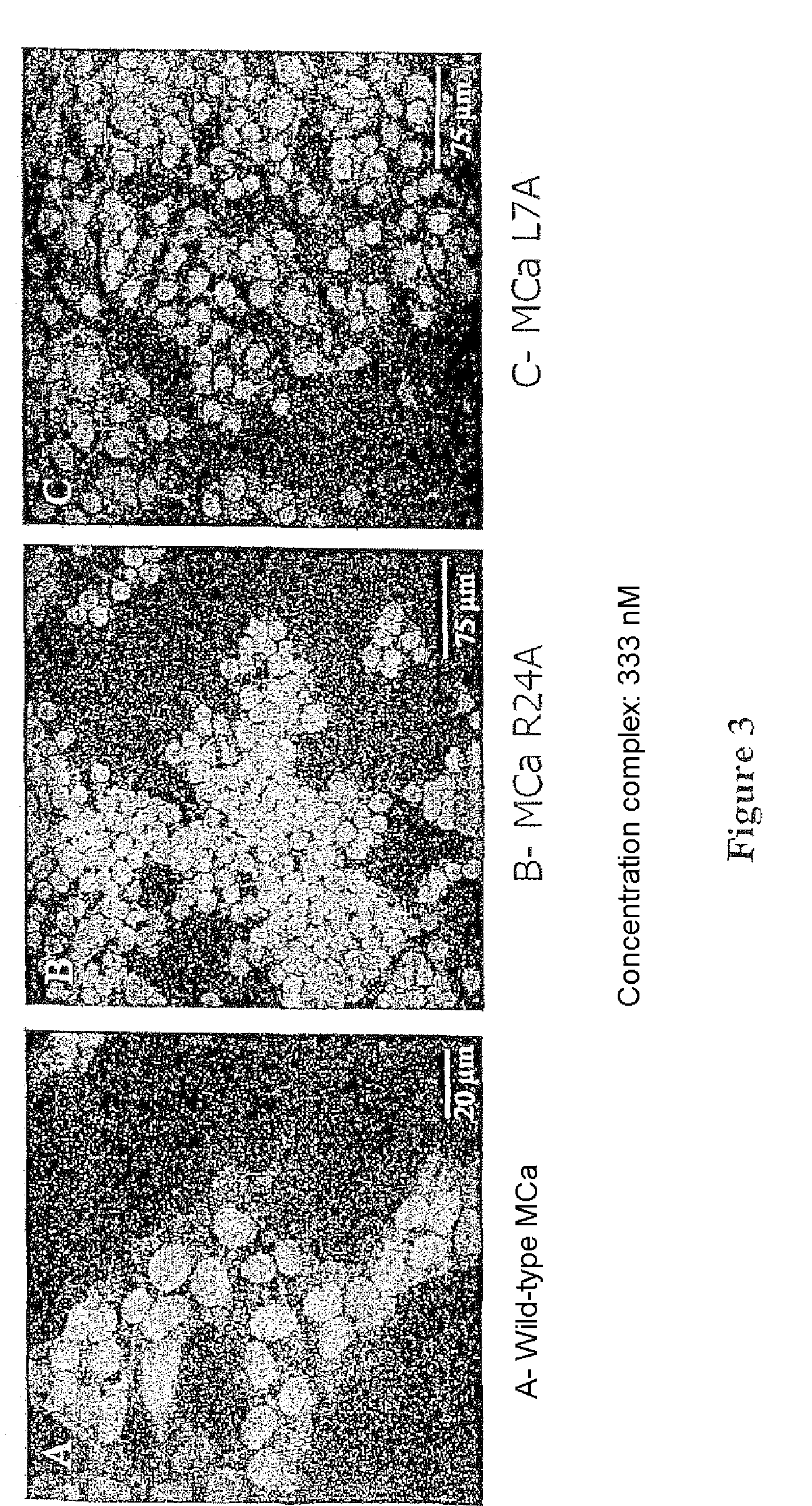Peptides derived from maurocalcine used as vectors for intracellular addressing of molecules of interest
a technology of maurocalcine and peptides, which is applied in the field of peptides derived from maurocalcine, can solve the problems of not being able to identify a general, not being able to be used in vivo, and particular cytoplasmic and nuclear compartments,
- Summary
- Abstract
- Description
- Claims
- Application Information
AI Technical Summary
Benefits of technology
Problems solved by technology
Method used
Image
Examples
example 2
Analysis of the Mechanisms Involved in the Cellular Penetration of Maurocalcine and of the Derived Peptides
a) The Penetration of Maurocalcine and of the Derived Peptides is Energy-Independent and Insensitive to Endocytosis Inhibitors
[0151]The possible contribution of an energy-dependent process in the entry of the MCab / Strept-Cy3 complexes into cells was studied (FIG. 8). The effect of a decrease in temperature on the entry of the MCab / Strept-Cy3 complexes shows that they still penetrate into the cells at 4° C. (FIG. 8B). At this temperature, the complex labels the membrane and the cytoplasm in a similar manner. The effect of pinocytosis / endocytosis inhibitors was also tested. Both amiloride (3 mM, FIG. 8C) and nystatin (50 μM, FIG. 8D) have no effect on the entry of the complex into the cells or on its relative distribution on the plasma membrane and in the cytoplasm, further confirming that the principle mechanism of entry of maurocalcine into the cell is not energy-dependent.
b) M...
example 3
Analysis of the Effect of the Biotinylated MCa-Derived Peptide / Strept-Cy3 Complexes on the Biological Activity of the RyR1 Receptor
1) Materials and Methods
a) Preparation of Heavy Sarcoplasmic Reticulum Vesicles
[0164]The heavy sarcoplasmic reticulum vesicles are prepared according to the method of Kim et al. (J. Biol. Chem., 1983, 258, 9662-9668) modified as described in Marty et al. (J. Biol. Chem., 2000, 275, 8206-8212). The protein concentration is measured by the Biuret method.
b) Tritiated Ryanodine Binding Assay
[0165]The heavy sarcoplasmic reticulum vesicles (1 mg / ml) are incubated at 37° C. for 2 hours and 30 min, in reaction buffer comprising 5 nM [3H]-ryanodine, 150 mM NaCl, 2 mM EGTA, 2 mM Ca2+ (pCa=5) and 20 mM Hepes, pH 7.4. Maurocalcine, the maurocalcine-derived peptides and their biotinylated derivatives are added before the addition of the heavy sarcoplasmic reticulum vesicles. The [3H]-ryanodine bound to the heavy sarcoplasmic vesicles is measured by filtration through...
example 4
Use of Maurocalcine or of Derived Peptides for the Cellular Penetration of Nanoparticles
[0173]Biotinylated maurocalcine was coupled to streptavidin-conjugated nanoparticles (QDOT®, QUANTUMDOT CORPORATION), according to the protocol recommended by the supplier. Streptavidin-coupled nanoparticles alone (QDOT® streptavidin conjugate, QUANTUMDOT CORPORATION) were used as a control. The nanoparticles have a diameter of 10 to 15 nM and are each coupled to 5 to 7 streptavidin molecules. HEK293 cell cultures were incubated for 1 hour with 100 nM of maurocalcine coupled to nanoparticles (QDOT®, QUANTUMDOT CORPORATION) or nanoparticles coupled to streptavidin alone, and the cells were then fixed and analyzed by confocal microscopy, as described in Example 1. FIG. 14 shows that maurocalcine allows cellular penetration of the nanoparticles.
PUM
 Login to View More
Login to View More Abstract
Description
Claims
Application Information
 Login to View More
Login to View More - R&D
- Intellectual Property
- Life Sciences
- Materials
- Tech Scout
- Unparalleled Data Quality
- Higher Quality Content
- 60% Fewer Hallucinations
Browse by: Latest US Patents, China's latest patents, Technical Efficacy Thesaurus, Application Domain, Technology Topic, Popular Technical Reports.
© 2025 PatSnap. All rights reserved.Legal|Privacy policy|Modern Slavery Act Transparency Statement|Sitemap|About US| Contact US: help@patsnap.com



